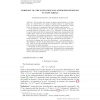19 search results - page 3 / 4 » Equilibria, Fixed Points, and Complexity Classes |
ICLP
2001
Springer
13 years 9 months ago
2001
Springer
We formally characterize alternating fixed points of boolean equation systems as models of (propositional) normal logic programs. To this end, we introduce the notion of a preferr...
ICML
2007
IEEE
14 years 6 months ago
2007
IEEE
We introduce a robust probabilistic approach to modeling shape contours based on a lowdimensional, nonlinear latent variable model. In contrast to existing techniques that use obj...
MOC
2010
13 years 2 days ago
2010
We introduce the concept of regular super-functions at a fixed point. It is derived from the concept of regular iteration. A super-function F of h is a solution of F(z+1)=h(F(z)). ...
KES
1998
Springer
13 years 9 months ago
1998
Springer
Attractor systems are useful in neurodynamics,mainly in the modelingof associative memory. Thispaper presentsa complexity theory for continuous phase space dynamical systems with ...
MP
2010
13 years 2 days ago
2010
Given a generic semidefinite program, specified by matrices with rational entries, each coordinate of its optimal solution is an algebraic number. We study the degree of the minima...


